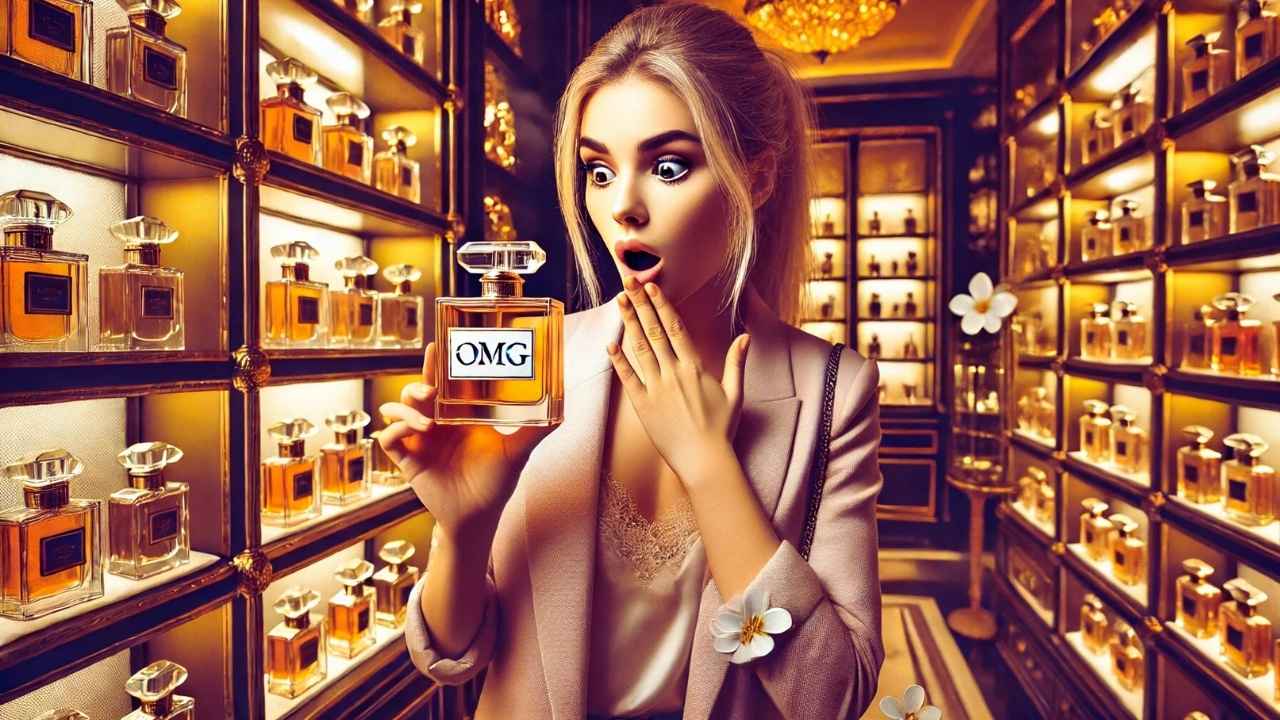I have always wondered why perfume can cost more than a fancy dinner. Many people ask, “Why is perfume so expensive?” or “Why does cologne cost so much?” The truth is, several factors drive these prices up. That is why we see expensive perfume from well-known brands like Chanel or Tom Ford.
Perfumes often sit in the luxury items category. Brands work with rare ingredients, refined production methods, and premium packaging. These elements set them apart from cheaper fragrance lines. When someone says, “Why are fragrances so expensive?” I point to the high-quality raw materials. Some perfumes include oud or saffron, both of which require intensive harvesting. That leads to higher costs.
I also notice that artisanal craftsmanship plays a massive role. Skilled perfumers spend time perfecting each blend. They do not rely on quick, mass-production tactics. They focus on detail and precision. If you think about “why is cologne expensive,” you will see that these niche products often feature small-batch processes. That pushes production costs higher.
Branding and marketing often increase the price too. Ad campaigns, celebrity endorsements, and fancy packaging cost money. Consumers often equate higher prices with better quality. That perception helps justify big markups. People ask, “Why are some perfumes so expensive?” The answer lies in these added layers of glamour.
Exclusivity is another factor. I have seen niche brands produce limited runs to build hype. Dior, Creed, and Kilian do this. They craft scents in smaller quantities. That keeps demand high. Shoppers view them as collector’s items. In a way, these perfumes become status symbols. Some buyers do not mind paying top dollar for that sense of prestige.
We also see that big names like Tom Ford or Byredo add more costs. They push unique scent profiles. They hire top-notch perfumers. They invest in elegant bottles. Each step adds to the final price.
The brand name itself can be a reason for a higher price tag. People might say, “Why is Tom Ford perfume so expensive?” The brand image, rare ingredients, and marketing all combine into one high-priced package.
Lastly, customer perception drives prices. Luxury items often come with a “you get what you pay for” mindset. Shoppers believe a costly perfume means better projection, longevity, and uniqueness. They often feel that “is expensive cologne worth it?” and decide yes if it elevates their style.
Perfumes do more than smell nice. They offer a luxurious experience. They highlight fine ingredients, refined methods, and strong branding. That combination justifies the cost in the eyes of many enthusiasts. If you want to learn more about fragrances and their secrets, check out my other resources at Perfumsy.com.
The Cost of Ingredients
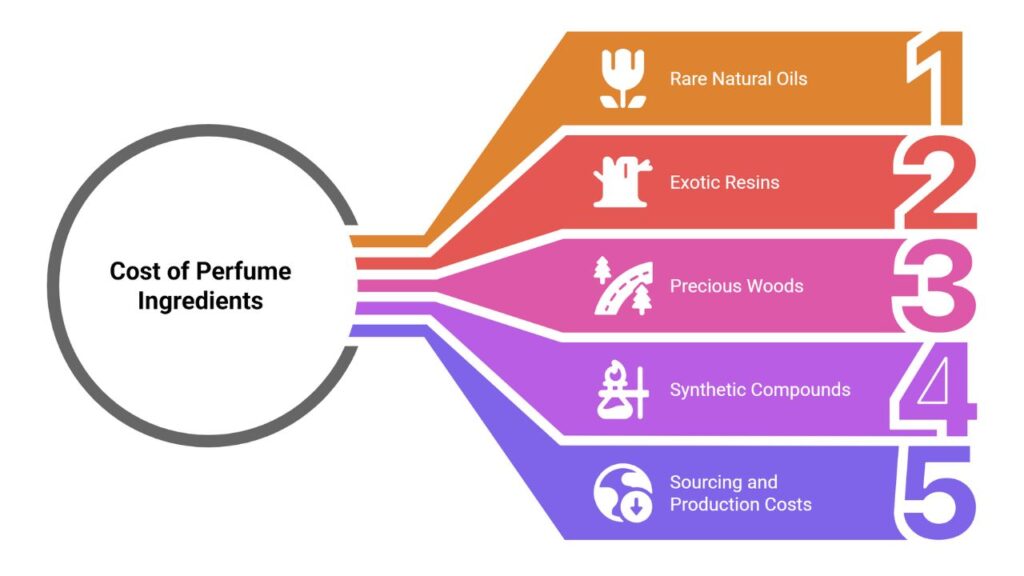
Whenever I see “why is perfume so expensive?” I look at the ingredient list. High-priced perfume ingredient choices drive up costs. Natural oils from rare flowers, exotic resins, or precious woods can cost a fortune. Perfumes featuring oud or jasmine absolute come with steep price tags.
I recall hearing that oud can be more expensive than gold by weight. It comes from agarwood trees infected by certain fungi. Harvesting the resin is tricky. Demand for oud is huge in luxury markets, which increases its price. That is one reason “why is cologne so expensive” when it includes oud.
Jasmine is another prized component. I have read that extracting jasmine absolute requires thousands of blossoms. Workers pick the flowers by hand at dawn to capture the richest scent. That manual process explains “why are perfumes so expensive” when they rely on jasmine. Each small bottle holds the essence of many flowers.
Some brands also use exclusive synthetics. These lab-created molecules are not cheap. They mimic rare natural scents or offer entirely new aromas. For instance, certain niche labels blend natural rose with synthetic accords to achieve a refined result. Synthetic creation demands chemical expertise and specialized facilities. That cost passes on to the customer.
Another example is orris root, derived from iris plants. It takes years to mature. The root must be stored before extraction. That process delivers a powdery, rich floral note. But it also costs a ton. This is why you may ask, “Why does perfume cost so much?” The rare components are not mass-produced like everyday fragrance oils.
Pricing also depends on the origin of the raw materials. Chanel invests in rose fields in Grasse, France, to ensure consistent quality. That dedication leads to higher production costs. The same goes for brands that source Tahitian vanilla or Haitian vetiver. Shipping and limited supply also factor in.
I compare perfume ingredients to fine dining. Top chefs demand the best truffles or caviar for their dishes. Perfume houses want premium oils and extracts. These raw elements are the heart of every luxury fragrance. That is “why are some colognes so expensive” or “why is kilian perfume so expensive.” They rely on top-grade naturals that cost more than cheaper synthetic fillers.
Ingredients alone do not explain everything. But they serve as the first building block for high fragrance prices. When I see “why is tom ford perfume so expensive,” I know he often uses real oud or rare florals that cost a lot. Then, brand positioning and craftsmanship push costs higher. We will explore those in the next sections.
Artisanal Craftsmanship and Production
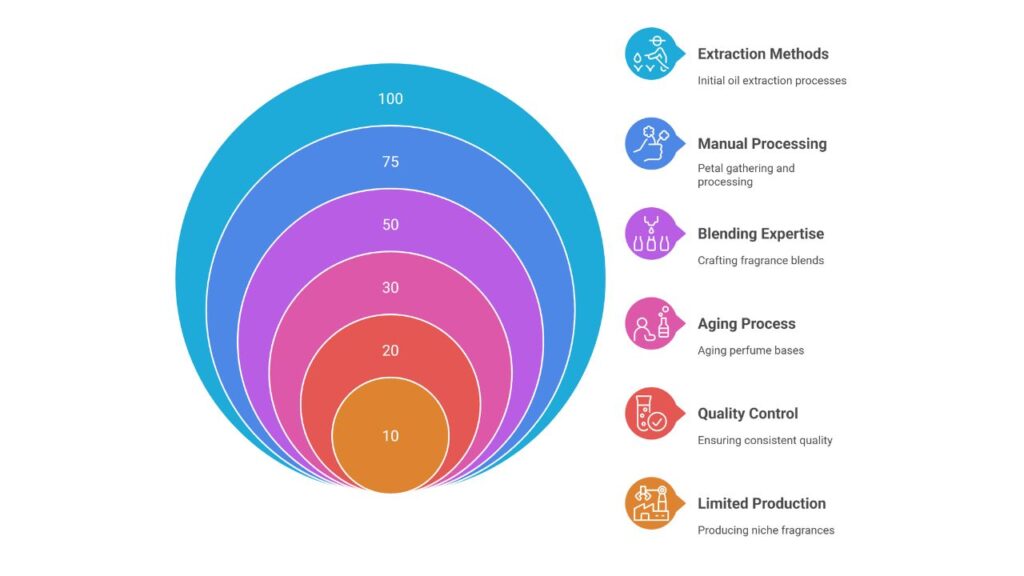
I believe that artisanal craftsmanship shows why perfume is expensive. Many luxury scents use traditional extraction methods. These steps include enfleurage, steam distillation, or solvent extraction. They all demand special equipment and skilled workers. When we ask, “Why does perfume cost so much?” we can see the old-world techniques at play.
Manual labor also raises the final price. For instance, workers gather petals by hand. They process them in small batches to ensure optimal yield. Overseeing each step requires expertise. Not everyone can blend fragrance oils in perfect harmony. That skill is known as the “nose.” Only a handful of master perfumers hold the experience to craft iconic scents.
Small perfume houses like Le Labo, Creed, or Jo Malone emphasize artisanal methods. They do not rely on giant automated lines. They might do hand-bottling or custom blends in store. This approach explains “why is cologne so expensive” for these niche labels. The personal touch and detail-oriented process create that high-end aura.
Artisanal production also involves aging. Some perfume bases rest in barrels for months or years. That step softens the edges of strong notes. It also helps the scent evolve. Extra time in storage means extra overhead costs for the brand. That cost passes on to the consumer.
High craftsmanship standards ensure consistent quality. Any flaw can ruin a batch. Producers invest in strict quality control. They test each component to confirm purity. This approach drives costs up. So “why are fragrances so expensive?” Because they pay for top-quality labor and exacting methods.
Another reason is small-scale operations. Big factories slash costs through bulk output. But niche perfume houses focus on limited runs. They cannot achieve the same economies of scale. That means each bottle carries a higher production cost.
For me, these artisanal steps are part of the fragrance’s appeal. I like knowing that “why is creed cologne so expensive” ties back to hand-selected ingredients and heritage techniques. It feels special. It is similar to buying hand-sewn couture fashion. The time and passion poured into each piece justify the higher price.
Artisanal craftsmanship affects the entire process. It starts with the extraction of delicate oils. It continues with the perfumer’s careful blending. It finishes with hand-filled bottles. Each part adds value. That is why I think many connoisseurs pay for “expensive perfume.” They support artistry that stands apart from mass-market sprays.
Branding and Marketing Expenses
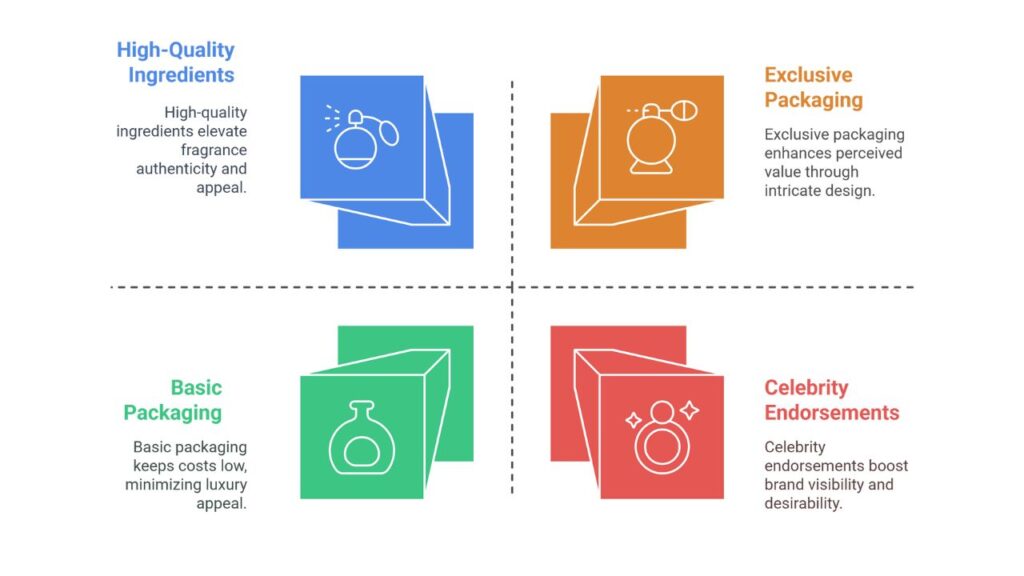
I see huge billboards for luxury perfume in major cities. Celebrities pose with fancy bottles. Glossy ads fill magazines. This marketing does not come cheap. When you ask, “Why is perfume expensive?” or “Why does perfume cost so much?” consider branding and promotion.
Big names like Dior, Chanel, or Tom Ford invest millions in ad campaigns. They hire famous actors or models for commercials. They host lavish launch events. This level of exposure helps them stand out. It also drives up the product’s final cost.
High-end packaging design also plays a role. I have seen beautiful glass bottles with intricate shapes. Some come with gold accents or hand-tied ribbons. These details look stunning, but they increase production expenses. Packaging can represent a significant chunk of the overall price.
Then we have distribution and retail overhead. Luxury perfumes appear in upscale department stores. Those shops charge premium rents. They also provide staff to assist customers. Brands mark up the price to cover these costs and maintain a prestigious image.
Marketing also relies on limited-edition releases. I spot “exclusive” bottles that celebrate holidays or special collaborations. These limited runs often include extra embellishments. That further boosts the price. People see them as collectibles. They willingly pay more for that sense of uniqueness.
A strong brand identity shapes consumer perception. Buyers associate Chanel with timeless elegance. They connect Tom Ford with daring luxury. They think of Dior as iconic. When a perfume house builds this kind of reputation, customers accept higher price tags. It is a status symbol.
This branding also ties back to packaging. Even the smallest detail on the box matters. Colors, fonts, and textures all deliver a “luxury vibe.” If you ask, “Why is cologne so expensive from these big designers?” The brand invests in the entire user experience, from the fancy bottle to the display case.
Marketing has a powerful effect on perceived value. Consumers believe that “are expensive colognes worth it?” because they have seen those ads. They trust the brand. That trust leads them to pay top dollar for the fragrance.
I think it helps to compare it to the fashion world. A basic T-shirt can cost a fraction of a designer one. The difference is brand prestige and marketing. Perfumes operate the same way. The bigger the marketing budget, the larger the brand presence, and the steeper the retail price.

The Role of Exclusivity and Niche Markets
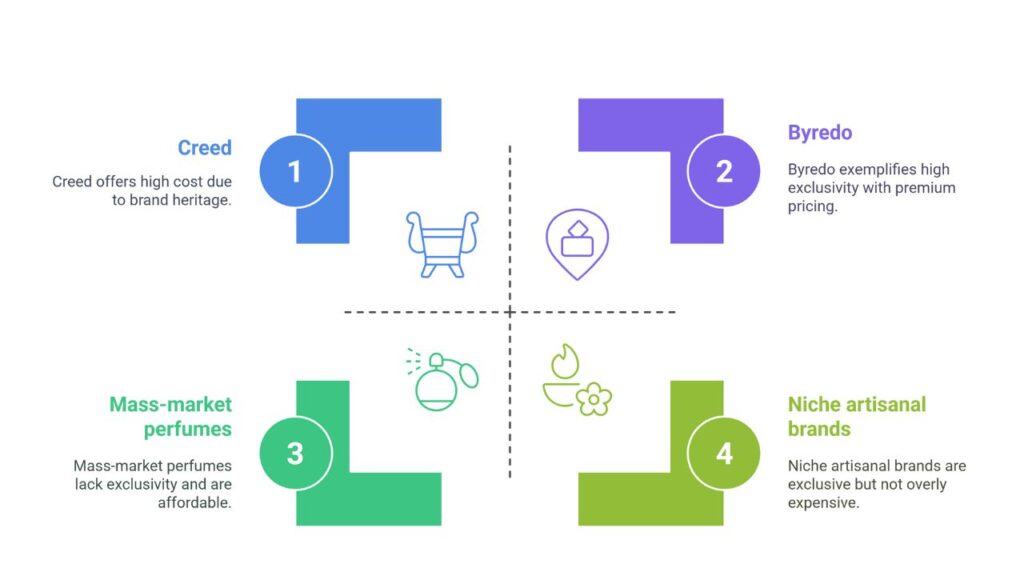
I have discovered that limited availability can skyrocket fragrance prices. People often ask, “Why are some perfumes so expensive?” One reason is exclusivity. Certain niche brands produce very few bottles for each collection. This strategy keeps demand high. It ensures that buyers feel special.
Niche perfumes often appear in select boutiques or brand-specific shops. That means they are not found on every mall shelf. This leads to a sense of discovery for fragrance lovers. They enjoy owning a scent that not everyone else can grab. Niche houses like Byredo, Le Labo, or Parfums de Marly thrive on this concept.
Limited production also costs more per unit. Smaller batches do not benefit from typical mass-production savings. If you make fewer bottles, each bottle ends up costing more to produce. That is part of “what makes cologne expensive.” I see it frequently in niche lines that only produce a few thousand units per release.
Sometimes, the brand crafts a unique backstory. They might highlight a special approach or a rare ingredient. They also charge a premium because that product has a distinct identity. People love telling stories about their exclusive scents. That personal connection helps justify the higher price.
Exclusive scents also lean on brand heritage. Creed, for example, prides itself on a centuries-old tradition. They mention how the brand served royalty. Tom Ford emphasizes sleek, modern luxury. They control distribution to uphold a high-end image. If you wonder “why is creed cologne so expensive?” or “why is tom ford cologne so expensive?” that curated sense of exclusivity is key.
Niche markets target fragrance enthusiasts who prize uniqueness. These customers often pay top dollar for rare or small-run scents. They do not want mainstream options. They crave perfumes that feel personal. That demand means fewer bottles but higher prices.
The same principle applies to “why is parfum de marly so expensive?” or “why is baccarat rouge 540 so expensive?” These labels produce scents designed for connoisseurs. Their fans see them as investments. Some collectors have entire wardrobes of exclusive perfumes. They do not mind a premium if it secures them a one-of-a-kind fragrance.
Exclusivity can also mean better materials. Many niche houses use all-natural or ethically sourced ingredients. They keep a strong commitment to eco-friendly practices. Those initiatives add to the cost. But they appeal to customers seeking something beyond a mass-market cologne.
Exclusivity and niche markets form a tight relationship. Fewer bottles, unique scents, and strong brand stories draw in dedicated fans. The result is expensive fragrances that carry a special aura. This dynamic extends to everything from small artisanal labels to big names with niche collections.
Price Comparison of Popular Perfumes
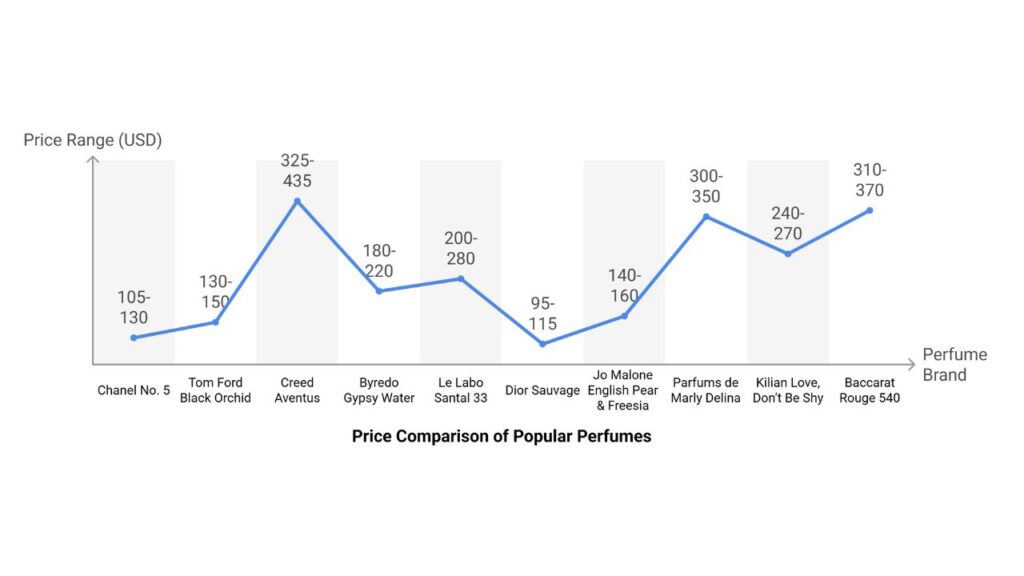
I wanted to see if these perfumes really cost that much more. So I gathered some typical prices from popular luxury brands. I realized that “why is cologne so expensive?” becomes clear when you compare them side by side. Let’s look at rough price ranges and examine what makes them so pricey.
| Brand / Fragrance | Approx. Price (50 ml / 1.7 oz) | Key Selling Points |
|---|---|---|
| Chanel No. 5 | $105 – $130 | Iconic floral aldehydic scent, classic brand |
| Tom Ford Black Orchid | $130 – $150 | Rich oriental notes, bold packaging |
| Creed Aventus | $325 – $435 | Luxury heritage, niche distribution |
| Byredo Gypsy Water | $180 – $220 | Scandinavian minimalism, unique notes |
| Le Labo Santal 33 | $200 – $280 | Handmade approach, city-exclusive releases |
| Dior Sauvage | $95 – $115 | Modern fresh-spicy profile, strong marketing |
| Jo Malone English Pear & Freesia | $140 – $160 | Simple, elegant blends, layering concept |
| Parfums de Marly Delina | $300 – $350 | Feminine floral-fruity notes, niche appeal |
| Kilian Love, Don’t Be Shy | $240 – $270 | Luxurious packaging, sweet floral structure |
| Baccarat Rouge 540 | $310 – $370 | Maison Francis Kurkdjian’s star, addictive aroma |
(Prices may vary by region and retailer. These are estimates based on current listings.)
I see that some fragrances from Dior or Chanel sit around $100 for a small bottle, while Creed Aventus can exceed $300. That cost difference is massive. So what makes cologne expensive? Heritage, distribution, and rare materials are all big factors.
Chanel No. 5 remains an icon. People ask, “Why is chanel perfume so expensive?” The brand invests in exclusive jasmine fields in Grasse. They also have a legendary status in fashion. That cachet allows them to charge more.
Tom Ford Black Orchid sits in the $130–$150 range. Tom Ford is known for edgy marketing, luxurious packaging, and potent scents. “Why is tom ford perfume so expensive?” We see the answer in artisanal processes, high-end branding, and rare notes like black truffle and orchid.
Creed Aventus dwarfs many mainstream fragrances in price. A 50 ml bottle can push over $400. People often say, “Why is creed aventus so expensive?” Creed uses a centuries-old perfume lineage, partial hand-crafting, and top-tier ingredients. They also control where it’s sold, which adds exclusivity.
Byredo fragrances usually cost around $180 for 50 ml. They have a modern flair. They are not as pricey as Creed. But they still cost more than your average designer cologne. They craft creative scent profiles and limited distribution. That approach supports the idea of “why are some colognes so expensive?”
Le Labo Santal 33 can go above $200. The brand’s concept is about fresh hand blending. They label each bottle with the user’s name. This personal touch appeals to fragrance enthusiasts who want a bespoke feel.
Dior Sauvage is comparatively more affordable. It ranges around $100. So “why is dior sauvage so expensive?” Some say it isn’t as high as niche brands, but it’s still a premium. Dior invests heavily in marketing with celebrities like Johnny Depp. That star power drives up brand value.
Jo Malone bottles cost about $140. They use minimal packaging but emphasize layering different scents. Some fans love that customization. Others feel the price is high for simpler compositions.
Parfums de Marly sits in the $300 range. They present regal imagery and highlight aristocratic inspirations. They also use high-end raw materials. So “why is parfums de marly so expensive?” Their brand story and opulent packaging add to the price.
Kilian perfumes also cost a lot. The packaging often resembles a small art piece. It sometimes includes a decorative coffret. That level of presentation explains “why is kilian perfume so expensive.” The fragrance itself is also quite complex, using rare notes in sweet or boozy blends.
Baccarat Rouge 540 stands out as a major star in recent years. People ask, “Why is baccarat rouge 540 so expensive?” It ties to Maison Francis Kurkdjian’s craftsmanship, plus the Baccarat crystal brand heritage. The scent is known for its strong sillage and unique sweetness. It has become a cult favorite.
These brands justify their prices with rare ingredients, meticulous processes, exclusive distributions, and strong marketing. You might also see a price increase year by year. For example, “le labo price increase” or “perfume price increase 2023.” Rising raw material costs and brand repositioning can push costs higher.
Comparisons and Observations
- Luxury brands like Chanel and Dior remain more affordable than niche houses like Creed or Kilian, but still cost more than mass-market scents.
- Niche brands limit production, use exclusive materials, and have smaller-scale operations. That results in more expensive fragrance lines.
- Consumer loyalty and strong brand identities let these companies keep prices high. Shoppers see the value in quality, uniqueness, or brand history.
When you line them up, you see that the “average price of perfume” can vary a lot. Mass-market colognes might be $50. But high-end perfumes easily exceed $300. People who buy these fragrances often enjoy the artistry behind them. They view them as little luxuries. It’s about more than just smelling good.
If you want more insights on perfume trends and guides, check Perfumsy.com for helpful articles. Luxury fragrance can be a hefty investment, but many enthusiasts find it worthwhile. These price comparisons offer a quick look at how each brand defends its premium cost.
The Economics of Perfume Manufacturing
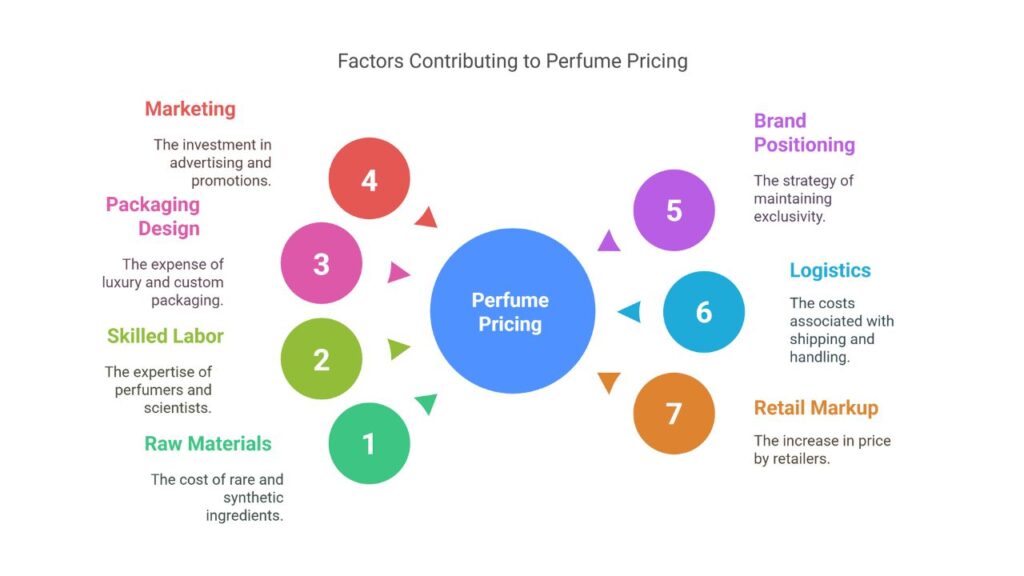
I get curious about the financial side of perfume production. I know that “why are perfumes so expensive?” partly comes from manufacturing costs. Let’s look at how these costs add up.
Raw materials form a big chunk. Rare absolutes or synthetics can cost hundreds or thousands per pound. Skilled labor ranks high too. Brands hire experienced perfumers. They also need scientists to ensure stability and longevity. Packaging design is another cost center. Luxury boxes, custom glass, and limited-edition containers add to the total.
Marketing impacts the pricing strategy. Big-name companies budget large sums for commercials and store displays. They recoup that from higher retail prices. Smaller niche brands spend less on ads, but they produce fewer bottles. That raises the per-unit cost.
Companies consider brand positioning. They may adopt a premium stance with lofty prices to maintain exclusivity. They also watch competition. If a rival brand sells at $300, they may set a similar price to appear equally luxurious.
Logistics can matter too. Shipping delicate glass bottles globally involves careful packaging. Insurance and import fees pile on. That overhead trickles down to consumers. Retailers also mark up perfumes. The final price might be double or triple the production cost.
When you ask, “Is cologne expensive to make?” yes, especially if it has rare ingredients. But the final retail figure includes more than raw materials. You pay for the brand story, the packaging, the marketing, and the distribution.
Consumer Perception and Value Assessment
I see that consumer perception makes a perfume worth the price. Shoppers often believe that “why is fragrance so expensive?” ties to quality. They associate higher prices with superior materials or lasting power. That belief allows brands to charge more.
Luxury items also carry emotional appeal. A fancy bottle from Tom Ford or Chanel can feel like a status symbol. I have friends who love collecting these expensive fragrances. They say it boosts their confidence. That intangible value justifies the cost in their eyes.
Marketing influences this perception. When ads feature celebrities or lavish settings, it links the perfume to an aspirational lifestyle. People like to buy into that dream. They pay for more than a smell. They want the brand’s promise of elegance or success.
Some fragrances also hold sentimental value. Maybe it’s a special gift or a wedding day scent. That emotional weight raises the perceived worth. People ask, “Are expensive perfumes worth it?” If it brings cherished memories, then the answer might be yes.
Word-of-mouth adds to the hype. Fragrance enthusiasts share reviews. They highlight the unique notes or the compliments they receive. This encourages others to try these premium scents. The cycle continues, and the brand remains in high demand.
Value assessment differs among shoppers. Some want a straightforward body spray. Others prefer a perfume that feels luxurious. If the scent lasts long or smells distinctive, many think it is worth the extra money.
Brand loyalty also matters. Once someone trusts a brand, they return for new releases. They expect top-tier performance every time. That attachment keeps them paying premium prices. In the end, consumer belief in quality, heritage, or exclusivity drives the market for high-priced perfumes.
Are Expensive Perfumes Worth It?
I often ask myself this question: “Is expensive cologne worth it?” The answer depends on your priorities. If you value rare ingredients, refined craftsmanship, and distinct scents, then yes, it can be worth the price. These perfumes often last longer on the skin, and people notice their uniqueness.
However, not every high-end brand will fit your style. Some cost more due to marketing rather than raw quality. You need to test different scents. Find what resonates with you. If you enjoy it, the investment might feel justified. If you can’t detect a huge difference, you might try cheaper alternatives.
I suggest sampling new perfumes at a store or asking for decants. That way, you can wear them for a few days before committing. Expensive does not always mean better. But many times, the craftsmanship and rare elements do create a remarkable product. Ultimately, it’s about personal preference and how that scent makes you feel. If it brings joy and confidence, it might be well worth the splurge.
